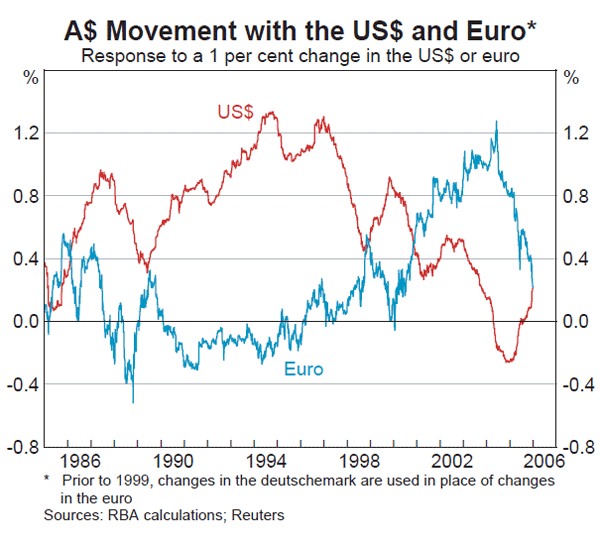Statement on Monetary Policy – February 2006 Box B: The Relationship of the Australian Dollar with the US Dollar and the Euro
Up until the mid to late 1990s, movements in the Australian dollar tended to track those in the US dollar (Graph B1) and it was often referred to as one of the ‘dollar bloc’ currencies.[1] However, over the past nine years the strength of this correlation has declined markedly, with a stronger correlation observed between the Australian dollar and the euro in recent years, particularly from late 2000 until mid 2004.

One possible explanation for the earlier positive correlation between the Australian dollar and the US dollar was the synchronicity of the Australian and US business cycles over that period.[2] The subsequent decline in the correlation occurred during the US dollar bubble of the late 1990s/early 2000s when the US dollar rose strongly against all other currencies, including the Australian dollar, as investors were attracted to US assets, most notably equities. The correlation of a number of other currencies, such as the euro, New Zealand and Canadian dollars and the British pound, with the US dollar also declined noticeably during this period.
Over the same period the correlation of the Australian dollar with the euro rose markedly. This was somewhat surprising given the divergent economic conditions and interest rate cycles experienced by the two economies during this period. The most plausible explanation was that this was the by-product of the US dollar bubble, which saw all currencies affected first by the flow of capital to the US and then by the subsequent reversal. This argument is supported by the observation that, with the stabilisation of the US dollar over the past year, the strength of the relationship between the Australian dollar and the euro has fallen significantly.
The correlations of the Australian dollar with the US dollar and the euro are now similar, and both relatively low. This is more in keeping with the relatively de-synchronised movement of the Australian economy at present, and especially the fact that it is benefiting more than most from the sharp rise in commodity prices.
The lines on the graph show the coefficients from a multivariate rolling regression of the daily percentage change in the Australian dollar on a constant and changes in the US dollar, euro and yen. Window length is 260 days; all variables are priced in terms of Swiss francs. The higher the value, the closer the two currencies move together. As the graph shows, since late 2000, the coefficient on the euro has exceeded that on the US dollar. [1]
See C Kent and D Norman (2005), The Changing Nature of the Business Cycle (available at <http://www.rba.gov.au/publications/confs/2005/>). [2]